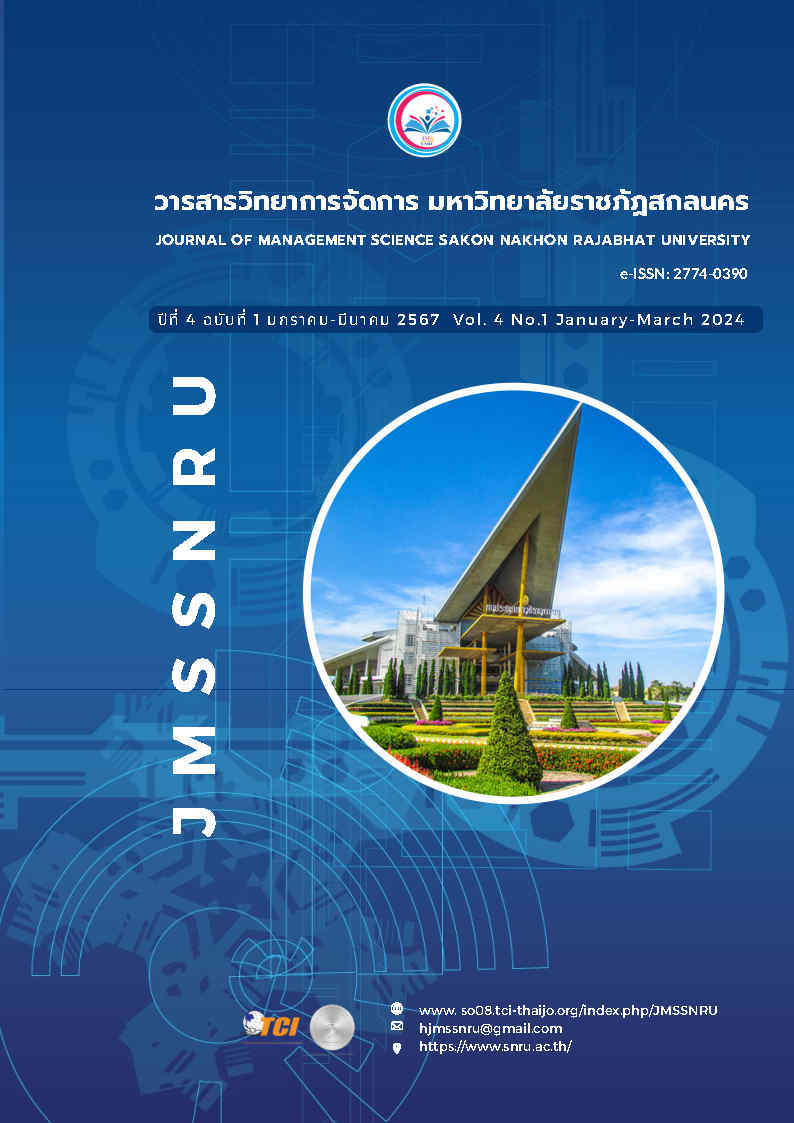TRANSFORMATIVE LEADERSHIP IN THE CENTURY 21ST OF SCHOOL ADMINISTRATORS UNDER THE OFFICE OF NONGBUALAMPHU PRIMARY EDUCATIONAL SERVICE AREA 2
Keywords:
Development guidelines, Transformational leadership, 21st century, School administratorAbstract
The purpose of this research study was to study the level and methods for developing transformational leadership in the 21st century among school administrators under the jurisdiction of the Nong Bua Lamphu Primary Educational Service Area Office, Area 2. The population and sample group were 290 people. The multistage random sampling was used. The research tools were questionnaires and interviews. The accuracy of the questionnaire is between 0.67 and 1.00. The confidence value is 0.92. Data was collected by the google forms program via email. To analyze the data, the researcher used frequency, percentage, mean, and standard deviation. and content analysis. The research showed that 1) the overall level of transformational leadership in the 21st century was at a high level and found that every aspect was at a high level. The aspect with the highest average was the change management, human relations, and leadership competencies respectively. The aspect with the least average value was the desired characteristics of future leaders. 2) Guidelines for developing transformational leadership in the 21st century for administrators included administrators should study the social system in educational institutions, which included policy, educational institutions, and organizational culture. Learning styles consisted of language, communication, participation consulting measurement and evaluation media and equipment for teaching the curriculum, teaching methods, and attitudes, beliefs personnel actions was as basic information for managing educational institutions, as well as including creating an impression or creating a good image for the organization that demonstrated appropriate behavior, building trust, team motivating, and applying the characteristics of the Sufficiency Economy Philosophy to life and work, including moderation, reasonableness, and having good immunity.
References
ชาญ คำภิระแปง. (2560). รูปแบบการเสริมสร้างภาวะผู้นำการเปลี่ยนแปลงในศตวรรษที่ 21 ของผู้อำนวยการกลุ่มนโยบายและแผน สังกัดสำนักงานคณะกรรมการการศึกษาขั้นพื้นฐาน. วิทยานิพนธ์ปริญญาดุษฎีบัณฑิต สาขาผู้นำทางการศึกษาและการพัฒนาทรัพยากรมนุษย์. เชียงใหม่: มหาวิทยาลัยเชียงใหม่.
บุญชม ศรีสะอาด. (2554). การวิจัยเบื้องต้น. (พิมพ์ครั้งที่ 9). กรุงเทพฯ: สุวีริยสาส์น.
ณัฐปาลิน นิลเป็ง. (2560). ผู้นำการเปลี่ยนแปลงในศตวรรษที่ 21, วารสารการพยาบาลและการดูแลสุขภาพ, 15(19).
ธีรศักดิ์ สารสมัคร. (2564). ภาวะผู้นำการเปลี่ยนแปลงของผู้บริหารในยุคการศึกษา 4.0 สังกัดสำนักงานเขตพื้นที่การศึกษามัธยมศึกษา เขต 29, การประชุมวิขาการและนำเสนอผลงานวิจัยระดับชาติ ราชธานีวิชาการ, 343-358, 2564.
นภัทร ธัญญวณิชกุล. (2564). แนวทางการพัฒนาภาวะผู้นำการเปลี่ยนแปลงในศตวรรษที่ 21 ของผู้บริหารสถานศึกษา สังกัดสำนักงานเขตพื้นที่การศึกษามัธยมศึกษา เขต 1, วารสารการวัดผลการศึกษา, 233-243.
สำนักงานเขตพื้นที่การศึกษาการศึกษาประถมศึกษาหนองบัวลำภู เขต 2. (2565). แผนปฏิบัติการประจำปี 2565. หนองบัวลำภู: กลุ่มนโยบายและแผนสำนักงาน.
รุ่งอรุณ หงส์เวียงจันทร์. (2560). รูปแบบการพัฒนาภาวะผู้นำการเปลี่ยนแปลงในศตวรรษที่ 21 ของผู้บริหารสถานศึกษาขั้นพื้นฐานในเขตภาคตะวันตก. ดุษฏีนิพนธ์ปรัชญาดุษฏีบัณฑิต สาขาวิชาการบริหารเพื่อการพัฒนาการศึกษา มหาวิทยาลัยราชภัฎกาญจนบุรี.
รุ้งนภา จันทร์ลี. (2562). ภาวะผู้นำการเปลี่ยนแปลงของผู้บริหารสถานศึกษาที่ส่งผลต่อการเป็นองค์กรแห่งการเรียนรู้ของสถานศึกษา สังกัดสำนักงานเขตพื้นที่การศึกษาประถมศึกษาจันทบุรี เขต 2. วิทยานิพนธ์ครุศาสสตรมหาบัณฑิต สาขาวิชาการบริหารการศึกษา มหาวิทยาลัยราชภัฎรำไพพรรณี.
สุภาพร ภูสมที. (2559). การศึกษาบทบาทภาวะผู้นำการเปลี่ยนแปลงของผู้บริหารสถานศึกษา สังกัดสำนักงานเขตพื้นที่การศึกษามัธยมศึกษา เขต 17. วิทยานิพนธ์ครุศาสตรมหาบัณฑิต สาขาวิชาการบริหารการศึกษา มหาวิทยาลัยราชภัฏรำไพพรรณี.
สำนักวิจัยและพัฒนาการศึกษา. (2558). ภาวะผู้นำการเปลี่ยนแปลงในศตวรรษที่ 21. สืบค้น 8 กุมภาพันธ์ 2566 จาก http://http://www.thaiedresearch.org/.
Bass, B. M. (1981). Stogdill’s handbook of leadership. New York: The Free Press.
Barnard, C. I. (1969). Organization and management. Cambridge, Massachusette Harvard University.
Bennis, W. G., & Nanus, B. (1985). Leadership: The strategies for taking charge. New York: Harper & Row.
Campbell, R., et al. (1977). Introduction administration. (4th ed). Boston: Allyn and Racon Inc.
Drucker, P. F. (1968). The Age of Discontinuity. New York: Harper and RoFullan, M. (2008). Learning to lead change: Building system capacity, core concepts. Retrieved March 30, 2011, from www.michelfullan.ca
Heller, F. A. & Porter, L. W. (1990). Personal characteristics conductive to success in business quoted in maureen guirdham, Interpersonal skills at work. Great Britain: Prentice Hall.
Katz, D. (1955). Skills of effective administrator. Harward Business Review, 23(1), 33–42.
Korman, A. K., & Tanofsky, R. (1975). Statistical problems of contingency models in organizational behavior. The Academy of Management Journal, 18(2), pp. 393-397.
Krejcie, R. V., & Morgan, D. W. (1970). Determining sample size for research activities. Educational and
Psychological Measurement, 30(3), 607-610.
Leithwood, K., & Jantzi, D. (1996). Toward an explanation of variantion in teacher’s perceptions of transformational school leadership. Educational administration quarterly, 32(4), 512-538.
Luthans, F. (2002). Organizational behavior (9th ed). New Jersey: McGraw-Hill.
Robbins, S. R., & Coulter, M. (1999). Management (6th Ed), Prentice Hall, Upper Saddle River, New Jersey.
Stedt, R. W. (1974). Managing career education programs. Englewood Cliffs, New Jersey: Prentice-Hall.
Stogdill, R. M. (1974). Handbook of leadership: A survey of theory and research. New York: The Free Press.
Downloads
Published
How to Cite
Issue
Section
License
Copyright (c) 2024 JOURNAL OF MANAGEMENT SCIENCE SAKON NAKHON RAJABHAT UNIVERSITY

This work is licensed under a Creative Commons Attribution-NonCommercial-ShareAlike 4.0 International License.
An article published in the Journal of Management Science. Sakon Nakhon Rajabhat University is the opinion, copyright and responsibility of the author of the work.






